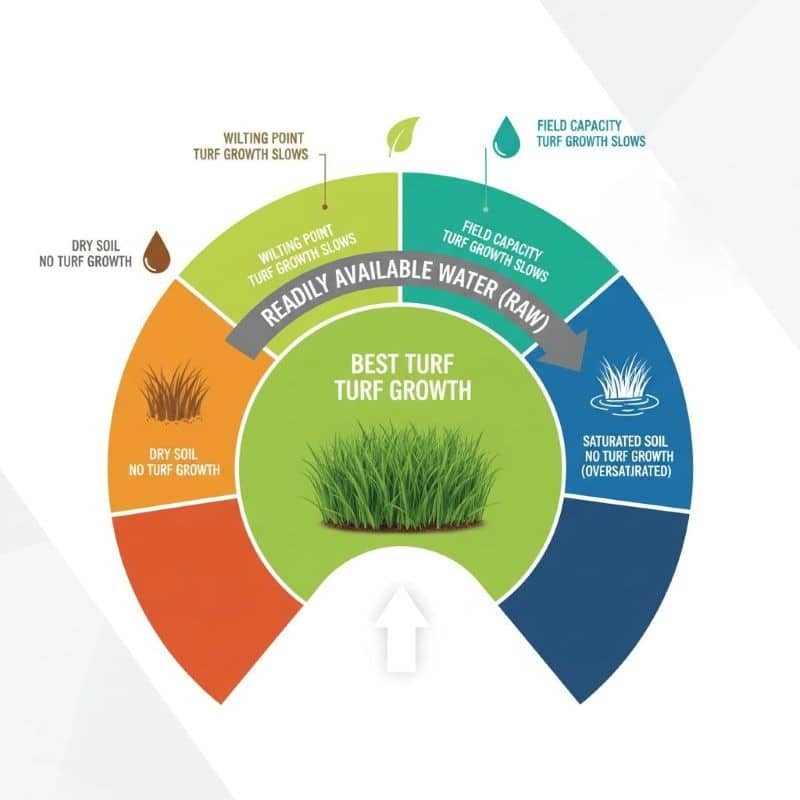Australian Turf Irrigation Calculator
Background
This free Australian Turf Irrigation Calculator is the only irrigation tool that uses:
- Live ET₀ weather data.
- The Soil water-holding capacity.
- Rainfall effectiveness.
- Turf species-specific crop coefficients.
This produces an accurate irrigation figure for turfgrass based on real-time data. It is designed for sports turf managers, councils, golf courses and professional lawn care.
The calculator replaces fixed schedules and guesswork with evidence-based, location-specific irrigation planning.
Accurate irrigation planning depends on how much water turf uses in a day. Turf water use is driven by the weather (especially heat), the soil water-holding capacity, and the species that is growing.
The Gilba Turf Irrigation Calculator converts all these factors into a daily irrigation requirement in mm/day. It uses the FAO-56 evapotranspiration method, principles of soil physics, how effective any rainfall is, and the irrigation efficiency.
This tool calculates the exact daily irrigation that turf needs in mm/day.
This calculator follows FAO-56 evapotranspiration methodology, USGA soil-water guidelines, and validated Australian PAW/AD values used in professional turf irrigation scheduling.
Why this matters
Turf water use changes every day, so fixed irrigation schedules quickly become inaccurate. If you rely on fixed schedules and weekly timers it almost always lead to over- or under-watering.
This calculator removes that guesswork and bases irrigation on actual atmospheric demand, soil water storage, and rainfall effectiveness.
The result is better turf quality, reduced stress, and more efficient water use. For example, did you realise that a couch sports field in Sydney on a 35°C day typically needs 4 to 6 mm irrigation once you account for any rainfall.
Related resources: Argentine Stem Weevil Predictor. Overseeding timing guide. Grass Seed for Oversowing. Soil Wetting Agent Selector. Traffic Tolerance Calculator.
Real-Time Weather Data (ET₀)
The tool uses live Open-Meteo weather feeds, and includes the FAO-56 reference evapotranspiration (ET₀).
- ET₀ measures the atmospheric demand for water.
- ETc (actual turf use) = ET₀ × Kc.
- Kc varies by turf species. This figure is based on canopy density, shoot architecture, and stomatal conductance.
The calculator includes Kc values that are validated against warm-season and cool-season turf studies for:
- Kikuyu.
- Couch (Bermuda).
- Tall fescue.
- Perennial ryegrass.
- Bentgrass.
- St Augustine (buffalo grass).
This approach follows FAO-56 standards and matches current irrigation science.
Soil Type and Water Holding

Figure 1: Water-holding capacity changes with soil texture. Data adapted from Alberta Agriculture (2004).
Soil type strongly affects how much water a soil profile can store:
- USGA sands and coarse sands. These have very low Plant Available Water values (PAW) and tend to dry rapidly.
- Sandy loams and loams. These hold more water than sands which means longer irrigation intervals.
- Clay loams. These can store more water but it tends to infiltrate much more slowly.
The calculator uses PAW and allowable depletion (AD) to calculate:
RAW (Readily Available Water)
= root depth × PAW × AD
This determines when you need to irrigate, not just how much water you need to apply.
Effective Rainfall
Not all rainfall reaches the turf rootzone. Runoff, canopy interception, evaporation, and shallow infiltration reduce its effectiveness.
You can set the effective rainfall percentage based on the site behaviour (sports fields, golf greens, sand profiles, etc.).
The calculator applies:
Net Irrigation = ETc – Effective Rainfall
Gross Irrigation = Net ÷ (Efficiency ÷ 100)
This ensures the actual water delivered to roots meets the daily requirement.
How to Use the Turf Irrigation Calculator
- Choose a preset location or enter latitude/longitude.
- Select turf species.
- Select soil type.
- Enter irrigation efficiency (%).
- Enter effective rainfall (%).
- Press Calculate.
The tool then:
- Pulls today’s ET₀ and rainfall.
- Calculates ETc.
- Adjusts for rainfall.
- Outputs net and gross irrigation (mm/day).
- Calculates RAW, irrigation interval, and recommended dose per event.
This supports transparent scheduling for councils, golf courses, stadiums, and turf professionals.
Turf Irrigation Requirement (mm/day)
How This Calculator Works
1. ET₀ (Reference Evapotranspiration)
Pulled live from the Open-Meteo weather API. This measures how much water turf would use under reference conditions.
2. Kc (Crop Coefficient)
Each turf species has a specific Kc value. ET₀ × Kc = actual turf water demand (ETc).
3. Effective Rainfall
Only a percentage of rainfall contributes to soil wetting. You control this percentage.
4. Net Irrigation
ETc – effective rainfall.
5. Gross Irrigation
Adjusts for irrigation system efficiency:
Gross = Net ÷ (Efficiency ÷ 100)
6. RAW – Readily Available Water
Based on soil type, root depth, and allowable depletion:
RAW = Root depth × PAW × AD
7. Irrigation Interval
Days until RAW is exhausted:
Interval = RAW ÷ ETc
8. Irrigation Dose
The amount applied per irrigation event:
Dose = RAW ÷ (Efficiency ÷ 100)
FAQ on The Turfgrass Irrigation Calculator
What is ET₀ and why does it matter for irrigation?
ET₀ (reference evapotranspiration) is a measure of how much water a reference crop would use under the day’s weather conditions. It incorporates temperature, solar radiation, humidity, and wind speed. These are all factors that drive turf water loss.
You calculate Actual turf water use (ETc) by multiplying ET₀ by a crop coefficient (Kc). Because ET₀ changes daily, it provides the most accurate indicator of how much water turf needs.
How do I calculate irrigation intervals for turf?
Irrigation intervals depend on how much water the soil can store (RAW) and how fast turf uses the water (ETc).
You calculate RAW by using root depth, soil plant-available water, and allowable depletion. The interval is then:
Interval (days) = RAW ÷ ETc
Sand profiles give shorter intervals, whilst loams and clay loams allow longer periods between irrigation events.
How does soil type affect turf irrigation?
Soils differ in their ability to hold water. In USGA sands and coarse sands water drains rapidly. These require frequent irrigation as they are only are able to store small amounts of water.
Sandy loams and loams can store moderate amounts of water and so they can cope with extended irrigation intervals.
Clay loams hold the most water but this tends to move into the soil slowly.
The turf irrigation calculator uses soil PAW. It takes account of the allowable depletion to adjust RAW and produce an accurate irrigation interval for each soil type.
What is the difference between net and gross irrigation?
The net irrigation is the actual water deficit that turf needs to replace ETc after accounting for effective rainfall.
The gross irrigation is the amount of water that you must apply through your system to deliver the net amount to the rootzone. It corrects for distribution uniformity (DU) and system losses:
Gross = Net ÷ (Efficiency ÷ 100)
Gross irrigation is always higher than net irrigation. This is because no irrigation system applies water perfectly.
How much should I water my turf in summer in Australia?
Warm-season turf usually needs 3 to 6 mm/day, while cool-season turf may require 5 to 8 mm/day in hot conditions. Actual demand depends on heat, wind, sunlight, and soil type. The calculator uses ET₀, Kc, rainfall and soil water storage to return a daily requirement rather than a guess.
References.
Allen, R.G., Pereira, L.S., Raes, D., Smith, M. (1998). FAO Irrigation and Drainage Paper 56: Crop Evapotranspiration. FAO.
https://www.fao.org/4/x0490e/x0490e00.htm
Beard, J.B. (1973). Turfgrass: Science and Culture. Prentice-Hall.
Beard, J.B., & Kenna, M.P. (2008). Water Quality and Quantity Issues for Turfgrasses in Urban Landscapes. Council for Agricultural Science and Technology (CAST). https://www.cast-science.org/
Carrow, R.N., Duncan, R.R. (2011). Best Management Practices for Turfgrass Water Conservation. USGA.
Environmental Manual for Crop Producers in Alberta (2004) by Alberta Agriculture, Food and Rural Development.
Ferguson, B., Gelen, G., & Marcus, M. (2019). Turfgrass evapotranspiration and irrigation management in warm-season species. Agronomy Journal.
Jones, H.G. (2004). Irrigation scheduling: advantages and pitfalls of plant-based methods. Journal of Experimental Botany.
Open-Meteo. Global weather API. https://open-meteo.com/
USGA Green Section. 2018. USGA Recommendations for a Method of Putting Green Construction.

Jerry Spencer
Jerry has an Hons Degree in Soil Science (1988) from Newcastle Upon Tyne University. He then worked as a turf agronomist for the Sports Turf Research Institute (STRI) until 1993.
He gained a Grad Dip in Business Management from UTS in 1999. He has held a number of technical roles for companies such as Arthur Yates (Commercial Technical Manager) and Paton Fertilizers (Organic, turf specialty and controlled release fertiliser) portfolios.
In 2013 he established Gilba Solutions as independent sports turf consultants and turf agronomists. Jerry has written over 100 articles and two books on a wide range of topics such as Turf Pesticides and turfgrass Nutrition which have been published in Australia and overseas.



